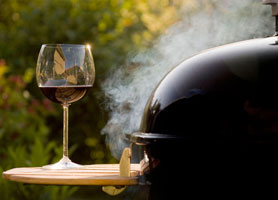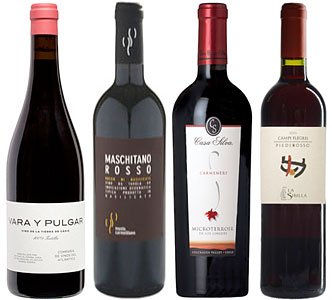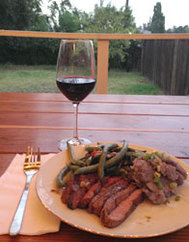| « Previous | News | Next » |
August 20, 2015
Summer Sipping Primer 2015, Part 2: Rebel Reds
 Lest we should let whites have all the fun this summer, we present you with part two of our Summer Sipping series: a roster of fun red grapes—some rare, some just a bit wacky, all unconventional provocateurs that are great for spicing up a wine list or a BBQ.
Lest we should let whites have all the fun this summer, we present you with part two of our Summer Sipping series: a roster of fun red grapes—some rare, some just a bit wacky, all unconventional provocateurs that are great for spicing up a wine list or a BBQ.
 2012 Vara y Pulgar Vino de la Tierra de Cádiz (Tintilla de Rota)
2012 Vara y Pulgar Vino de la Tierra de Cádiz (Tintilla de Rota)
Tintilla de Rota is a black-skinned, mysterious grape from the Jerez region in Spain, cloaked in secret identities: known as Xeres in California, Morrastel in the Languedoc, Tinta Miúda in Portugal, and most likely the same grape as Graciano—once part of the Rioja blend, whose low yields and propensity toward downy mildew made it fall out of favor there. (For a really in-depth look at the amphelography, check out this article on the Fringe Wine blog.) Winemaker Alberto Orte discovered a few cuttings that had survived phylloxera in abandoned vineyards in Jerez and has created the first 100% Tintilla bottling in over a century.
Orte is half of the duo that makes up Olé Imports, a company that brings unique, value-driven Spanish wines to the U.S. He and Patrick Mata started in 1999 with 3 bottles, and today import over 100. They also produce wines in 18 appellations across the Iberian peninsula. Their Tintilla is organically grown in white chalk Albariza soil near the town of Cádiz in southwestern Spain. The wine is aged in a combination of large cement and oak vats, then finally in French oak barrels. This grape may need to be treated with kid gloves, but its deeply colored and perfumed wine is certainly worth it.
The 2012 is inky black in color, with a savory complex nose that suggests forest floor, mint leaf, earth, leather, blackberry, tobacco, and pine. On the palate it opens to a softer expression, with notes of baking spice, brown sugar, and blackberry pie. It’s medium bodied, though drinks surprisingly lighter in the mouth; it has a really nice, almost acrobatic lift to it. It continues to develop in the glass and provide intrigue. Tannins are present but well integrated. Delicious!
2011 Musto Carmelitano ‘Maschitano’ Rosso di Basilicata IGT (Aglianico)
 Aglianico is southern Italy’s black-skinned, tannic, late-ripening dark horse. It thrives in the volcanic soil and mountainous terrain of Campania, especially Basilicata, where it makes up that region’s only DOCG. It may not have the international recognition of Nebbiolo or Sangiovese, but it can make powerful, long-lived wines with the potential for grace. But it needs the right touch: even that far south, the grapes are generally picked in November; much earlier and the tannins will be ferocious.
Aglianico is southern Italy’s black-skinned, tannic, late-ripening dark horse. It thrives in the volcanic soil and mountainous terrain of Campania, especially Basilicata, where it makes up that region’s only DOCG. It may not have the international recognition of Nebbiolo or Sangiovese, but it can make powerful, long-lived wines with the potential for grace. But it needs the right touch: even that far south, the grapes are generally picked in November; much earlier and the tannins will be ferocious.
Taming the wild beast is Elisabetta Musto Carmelitano’s superpower. She’s a fourth generation winemaker in the DOCG of Aglianico del Vulture in Maschito, just south of extinct volcano Monte Vulture. It’s this volcano that produces the mineral-rich soil in which she grows (organically) her grapes. With her winemaker, Fortuno Sebastiano, she vinifies in stainless, then ages in concrete, and avoids both fining and filtering to achieve the most natural expression of the grapes.
Her 2011 Rosso di Basilicata (Aglianico) has power and structure in spades. It’s dark plum colored in the glass. The nose exhibits dried cherry, fig, cassis, menthol, violet, and spice. It fills your palate with robust notes of mocha, caramel, and bitter chocolate. The finish shows why Aglianico is no joke: the tannins are firm and grippy, leading me to believe that this could cellar for several years and still stand up to a large hunk of meat. At only 13% abv, its relatively low alcohol provides a sense of balance to its tannic muscle.
Casa Silva 2007 ‘Microterroir’ Carmenère, Los Lingues Vineyard, Colchagua Valley
Carmenère was widely cultivated in the Médoc in the early 18th century. The story goes that this vigorous vine got the ax from most blends because of its tendency toward poor fruit set and subsequent low yields. Areas like Bordeaux with cloudy, cold weather around flower set are particularly bad for this phenomenon (called coulure). Chile, on the other hand, has the great benefit of being warm, dry, and nearly pest free; Carmenere was discovered there in 1994, and it’s since taken off like gangbusters, becoming something of the unofficial grape of the country.
Casa Silva has deep roots in the Colchagua Valley, south of Maipo, and can date their family back to 1892 and the earliest grape growers in the region. They also boast the oldest wine cellar in the valley. Despite such firm ties to history, they employ the latest technology in the cellar, and practice energy-efficient, sustainable winemaking whenever possible. Because their property is located at the foot of the mountains, its topography is very irregular and unique, making it an ideal place to undertake micro-terroir studies. By isolating very small parcels (.1 to .5 hectares), this research project is an attempt to scientifically understand why certain varietals thrive in certain soils, other than good old-fashioned trial and error.
 The 2007 ‘Microterroir’ is the result of detailed soil studies in the Los Lingues Vineyard. It is a deep raven-magenta color, with a fuschia rim. The nose offers up leather, rosemary, pine, leaf, coffee. The palate is smooth, with notes of rich milk chocolate, black, briary fruits, and peppercorn. The tannins are very integrated and silky on the finish. It’s ready to drink now. I paired it with Blue Apron’s Sirloin Steaks with Mashed Purple Potatoes and Summer Vegetables, and it was divine.
The 2007 ‘Microterroir’ is the result of detailed soil studies in the Los Lingues Vineyard. It is a deep raven-magenta color, with a fuschia rim. The nose offers up leather, rosemary, pine, leaf, coffee. The palate is smooth, with notes of rich milk chocolate, black, briary fruits, and peppercorn. The tannins are very integrated and silky on the finish. It’s ready to drink now. I paired it with Blue Apron’s Sirloin Steaks with Mashed Purple Potatoes and Summer Vegetables, and it was divine.
La Sibilla 2013 Piedirosso, Campi Flegrei, Campania
Piedirosso is a light red grape indigenous to the coast of Campania, generally on the islands of Ischia and Capri. It literally translates to “red feet” because of its reddish, clawlike stems.There’s some scuttlebutt that it is part of the Malbec family (see Nicolas Belfrage’s Brunello to Zibibbo: The Wines of Tuscany, Central and Southern Italy), but that’s not unequivocally acknowledged. It’s often used as a blending wine—very few producers make a 100% Piedirosso.
La Sibilla is one of the handful who do. They own a small, family-run winery in the town of Campi Flegrei, just north of Naples. Run by Luigi di Meo and his family, they grow ungrafted Falanghina (and in fact have the oldest Falanghina vines in the world at 200+ years) and ungrafted Piedirosso. The magic lies in their soil: it’s so sandy that it’s naturally phylloxera resistant, so there’s no need to graft onto other rootstock. The family grows five different strains of Piedirosso, and selects for aromatic intensity when making the final blend. The result is a wine that has a natural tendency toward low alcohol and high acidity. It is a light plum color, with vibrant hints of red cherry in the glass. The nose has a light gamey layer that gives way to reveal red currants and cranberry sauce. It’s gorgeous on the palate, with notes of dried cherry, cranberry, baking spice, and currants. This is a grilled salmon BFF, and would be great with grilled bratwurst or a charcuterie plate.
Written by Kate Soto
